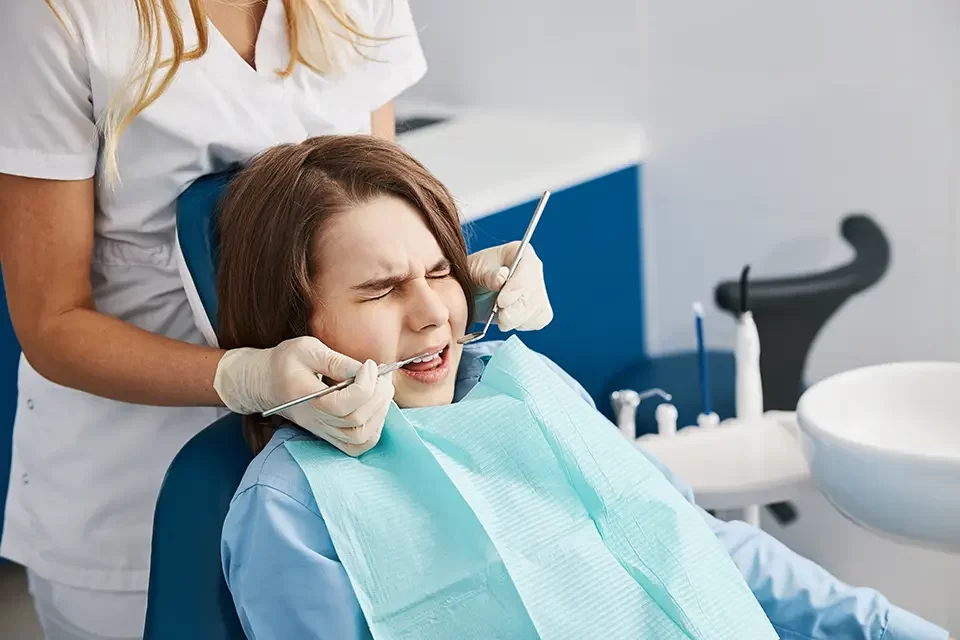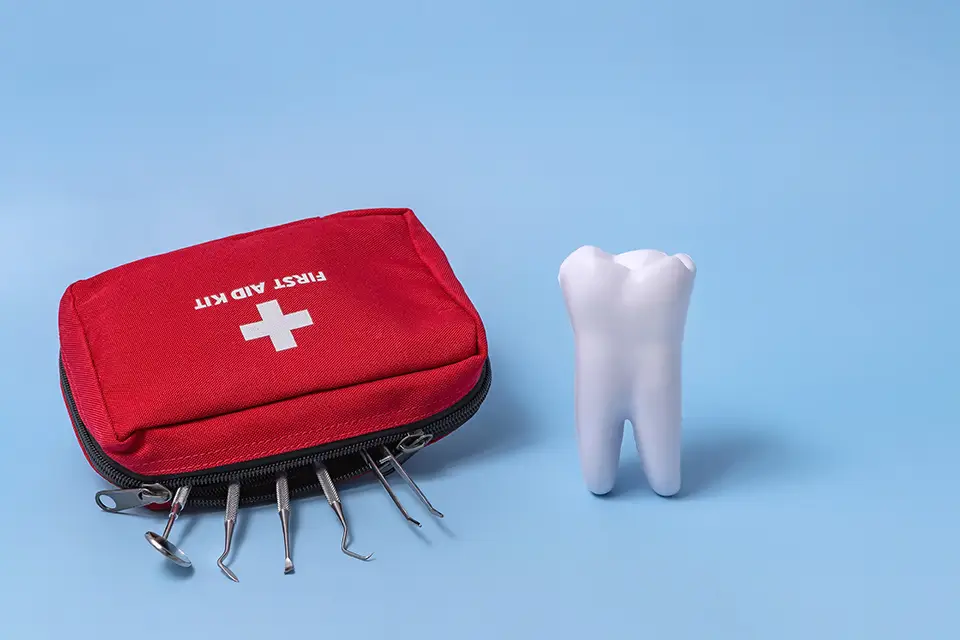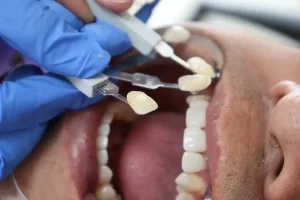Dental emergencies don’t wait for a quiet day. A crown can loosen at lunch, a tooth can crack on a seed, or a child can fall on the playground. In moments like these, you don’t need a lecture—you need a calm plan. This emergency dental care guide breaks down the first steps into something you can follow right now, even when you’re stressed. At FIFTH ST Dental in Etobicoke, Ontario, we hold same-day appointments for urgent cases and talk patients through those first minutes on the phone. Use the playbook below, then call us. Quick, steady action protects teeth, reduces pain, and keeps small problems from becoming big ones.
Emergency Dental Care Guide: The First Five Minutes (Do This First)
The early moves matter most. They’re simple, and they work.
- Stop the bleeding. Fold clean gauze (or a damp cloth) and press firmly for 10–15 minutes without peeking.
- Save what you can. Put any tooth fragments, a lost filling, or a dislodged crown in a small container.
- Rinse—don’t scrub. If a tooth is dirty, a gentle rinse with milk or saline is enough. Skip soaps and alcohol.
- Cold outside only. A cold compress on the cheek keeps swelling down; avoid heat, which can make throbbing worse.
- Call us. A quick description lets us triage, give targeted tips, and prepare before you arrive.
That’s the backbone of this emergency dental care guide: stop the bleeding, protect the area, and get expert eyes on it fast.
More: Pain-Free Root Canal Treatments in Etobicoke
What's Truly Urgent—and What Can Wait a Day
Not everything is a siren situation. A tiny corner chip with no pain can often wait 24–48 hours. But deep, throbbing pain, facial swelling, fever, a knocked-out or displaced tooth, or bleeding that won’t stop means: come in now. When in doubt, call—our team will use this emergency dental care guide logic to slot you into the right level of urgency.

Emergency Dental Care Guide: Pain, Swelling, and Possible Infection
You can make the next hour easier with a few smart choices.
- Use anti-inflammatories (if safe for you). Ibuprofen or naproxen reduces swelling and pain; follow the label or your provider’s guidance.
- Stay elevated. Lying flat increases pressure; two pillows help you rest.
- Warm saltwater rinses. Gentle swishing soothes tissue; no vigorous rinsing if you’re trying to protect a blood clot.
- No home surgery. Don’t lance bumps, drain anything, or “pop” a swollen spot. If infection is brewing, quick, focused care is safer and works better.
This part of the emergency dental care guide is all about comfort while you’re on your way to the clinic.
Broken, Loose, or Knocked-Out Teeth: Exact Steps to Follow
A cracked tooth? Avoid chewing on it and keep the area clean. A crown that popped off? Save it—temporary dental cement can hold you over for a night, but a proper re-cement or remake prevents leaks and sensitivity. If a tooth is knocked out entirely, timing is everything:
- Pick it up by the crown, not the root.
- Rinse gently with milk or saline if dirty. No scrubbing.
- Reinsert (adult teeth only) if you can. Push it back into the socket with steady pressure, then bite on gauze.
- If you can’t reinsert, store in milk (or tuck inside the cheek for older children/adults who won’t swallow it) and come in immediately.
The first hour offers the best survival odds. This is the most time-sensitive part of the emergency dental care guide.
Emergency Dental Care Guide: While You Wait to Be Seen
Short-term comfort buys you time and protects healing tissue.
- Soft, cool foods: Yogurt, scrambled eggs, smoothies by spoon, mashed potatoes.
- Skip irritants: Very hot, spicy, sharp, or crunchy foods; alcohol-based rinses; and smoking.
- Cover sharp edges: Orthodontic wax over a jagged tooth or bracket protects cheeks and tongue.
- Hydrate: Dry mouth makes everything feel worse; water helps comfort and healing.
When to Choose the ER Instead of the Dental Chair
Most tooth and gum problems belong to us. But if you have trouble breathing or swallowing, uncontrolled bleeding, a suspected jaw fracture, or head trauma with loss of consciousness, go to the ER first. Otherwise, the safest, fastest route is your dental team—this emergency dental care guide is written with that in mind.
What We'll Do at Your Emergency Visit
Expect a focused, stepwise plan: a quick history, targeted X-rays, and tests to pinpoint the source. Treatment might include smoothing sharp enamel, re-cementing a crown, placing a protective temporary, draining an abscess, easing a high bite, or starting root canal therapy if the nerve is inflamed. Before you leave, you’ll have both today’s fix and tomorrow’s plan—a key promise of this emergency dental care guide.
Costs, Timing, and Why the Answer Is Sometimes "It Depends"
Honesty helps under pressure. Fees reflect what’s needed that day—exam, imaging, a temporary or re-cement, or more complex care. A small polish-and-bond visit is modest; infections or fractures that require root canal therapy, extractions, or new crowns cost more. You’ll get a written estimate first and a clear explanation of what’s urgent now versus what can be staged. Transparency is part of our emergency dental care guide because surprises aren’t helpful when you’re in pain.
Prevention That Actually Reduces Emergencies
No one can prevent every mishap, but you can cut the odds.
- Nightguard: Protects teeth from clenching/grinding cracks.
- Sports mouthguard: Prevents broken teeth and lip injuries.
- Routine visits: Catch a loose filling or early crack before it becomes a 10 p.m. problem.
- Diet tweaks: Seeds, unpopped kernels, and ice are small but mighty culprits.
Quiet, preventive work is the first chapter—this emergency dental care guide is the second.

Why FIFTH ST Dental Is a Good Place to Land on a Bad Day
We leave room in the schedule for urgent cases, return calls quickly, and keep comfort front and centre. You’ll get precise numbing, a steady plan, and the option for same-day treatment when it’s appropriate. Bring fragments, lost crowns, or anything you’re unsure about—we’ll sort it. The goal of our emergency dental care guide is simple: calm the situation, save what matters, and get you comfortable fast.
Conclusion
In a dental emergency, small actions make a big difference: press to stop bleeding, protect the area, save what comes loose, and call. This emergency dental care guide turns panic into a short checklist you can follow, and our team at FIFTH ST Dental in Etobicoke handles the rest. If you see swelling, feel a deep ache, or notice a tooth out of place, don’t wait. Phone us now—we’ll talk you through immediate care, book you in, and map out the next steps so you can get back to your day with a clear plan.
FAQs — Emergency Dental Care Guide
I chipped a tooth, but it doesn't hurt. Can it wait?
It can, briefly—but call to schedule. Small chips can hide deeper cracks and sharp edges cut cheeks and tongues. A quick, smooth or bonded patch prevents bigger fixes later, which is why the emergency dental care guide suggests a prompt check.
My crown fell off at dinner. What should I do tonight?
Rinse the crown, store it safely, and avoid that side. Temporary dental cement can help for a day, but don’t use superglue. Bring the crown in; we’ll clean the surfaces, assess the fit, and re-cement—or plan a replacement if it won’t seal.
I woke up with facial swelling and throbbing pain. Do I need antibiotics?
You might—but antibiotics alone aren’t the fix. The source (often a trapped infection) needs drainage or definitive treatment. This emergency dental care guide prioritizes an urgent visit so we can relieve pressure and decide whether medication is appropriate.
A tooth got knocked out. What's the one step that matters most?
Reinsert it immediately (adult teeth only) if you can’t, store it in milk and come straight in. The first hour is crucial for long-term success—exactly why the emergency dental care guide pushes speed here.





